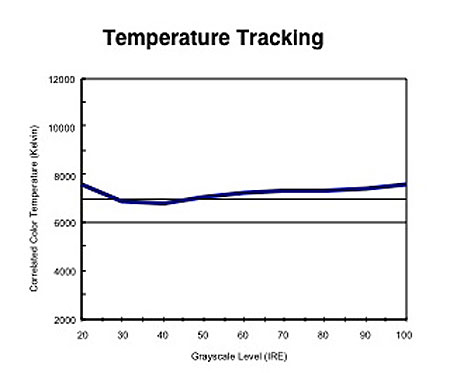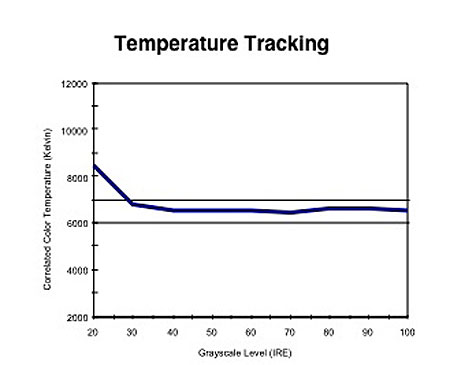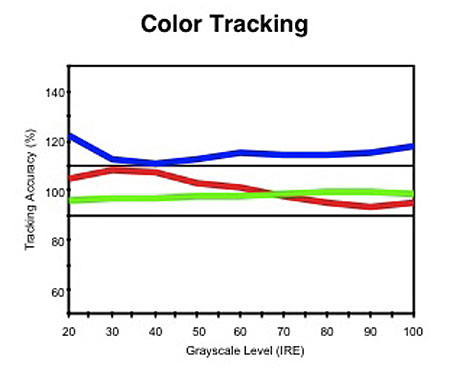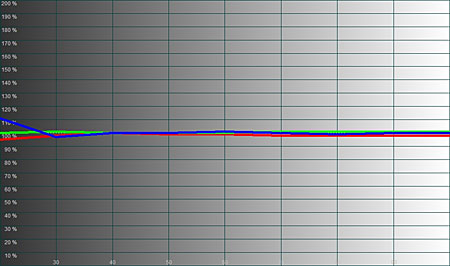Panasonic PT-50LCZ70 50" LCD LIFI Rear Projection HDTV Measurements
Summary
•The set's resolution was its greatest strength, rivaling that of much more expensive displays.
•The Panasonic's black level, shadow detail, and contrast ratio were all well below average for a modern set.
•The color performance, while visibly acceptable and often good, was strangely unstable
Details
Color
From the results shown in the accompanying figures, the Panasonic's color performance was good, but there's a lot more to the story. I'll begin with those figures, however.
Fig.1 shows the color temperature in the Warm setting, before calibration. It's on the high side, with an excess of blue that's quite visible in Fig.3. The latter shows the red, green, and blue balance; ideally, all three colors should converge on the 100% line.

Fig.1

Fig.2
Following calibration by a combination of service menu and user menu adjustments, however, the temperature was much closer to 6500K (Fig.2)—except at very low brightness, below 30IRE. (Many sets show noticeable deviations at very low brightness levels.) Fig.4 shows a dramatic improvement in the post-calibration red, green, and blue balance. A tight clustering around the 100% line indicates not only 6500K across the brightness range, but also a tight adherence to D6500. 6500K is a line on the CIE color chart. D6500 is the precise point on that line that a good calibration aims for.

Fig.3

Fig.4
The above results were the best case. But as noted earlier, the Panasonic's color was strangely unstable. Here is the chain of events that led me to this "unstable" characterization. If you prefer to avoid the details, skip down to The Bottom Line following the Day 1 and Day2 sections.
Day 1 of measurements
•Performed a full calibration using only the service menu. The result was close to 6500K, except at the very low end.
•When I dropped out of the menu (which requires cycling the set off, then back on), the color temperature increased to nearly 7400K!
•Some sets do exhibit such in-menu, out-of-menu instability (though they never should). To work around it, I re-entered the service menu and readjusted the color temperature to 5500K, hoping that when I drop out of it again the result will be closer to 6500K.
•I dropped out of the menu, but the temperature is still at or near 5500K! It did not change this time when I left the menu.
•Hoping this to be a one-time glitch, I re-entered the service menu and reset the color temperature to 6500K (fortunately I had written down my 6500K settings, so this didn't take long). But when I re-exited the service menu once more, the readings were back up to 7400K!
•Without making any further changes to the settings, I turned the set off, then on again. The measured color temperature now returned to 6500K!
•I then settled in for a few hours of additional testing that did not involve color temperature. Before calling it a day, I checked the color temp once more. It was back up to nearly 7400K! The set had not been cycled off then on again between these two last sets of color temp readings, nor did I re-enter and then leave the service menu again on this day following the last set of 6500K readings.
Day 2 of measurements
•The settings were not changed between day 1 and day 2, but the set was disconnected from the power line.
•When I fired up the set, it was now showing a color temperature of around 6500K, as per the Day 1 calibration. Good to go for more tests.
•I never re-entered the service menu on Day 2, but further refined the color temp, particularly at the extreme bottom end, using the white balance controls available in the Custom mode of the User menu (Pro setting).
•I sampled the color temperature at several brightness levels from 20IRE to 100IRE with different settings of the Color Management, AI Picture, and AI Brightness controls. The only one of these controls that affected the color temperature adversely was AI Picture, which raised the color temp by as much as 1500K. This was not a contributing factor to the problem on day 1, since AI Picture had been turned Off at that time.
•After several hours of additional testing that did not involve color temperature measurements, I checked the color temperature again. It was still 6500K. For one last check on the temperature stability before calling it a day, however, I turned the set off then fired it up again immediately following the cool-down cycle. The color temperature was again back up to nearly 7400K!
•Since I had completed all of my tests and viewing at this point (including additional days with the set not involving investigation of this particular issue) I decided it was time to wrap up the formal testing before this review turned into a research project.
The Bottom Line: It appears that the issue of the shifting color temperature may involve turning the set off and then on again, though there was that single outlying data point at the end of day 1 when it appeared to change without an intervening turn-off. Since the shift consistently ranged between about 6500K and 7400K and back again, with slight variations, it's unlikely to be either a random or lamp-related problem. Beyond that won't speculate.
The color space defined by the Panasonic's primary and secondary colors is shown in Fig.5. It's wider than the standard ATSC space, which is generally a sign of exaggerated or oversaturated color. But there was rarely any obvious sign of this in the set's visible color quality.

Fig.5
Resolution
The set's high frequency luminance (black and white) video response, at all resolutions (480i, 480p, 720p and 1080i) was excellent all the way out to the maximum burst frequency from my AccuPel test pattern generator (37.1MHz for 1080i and 720p, 13.5MHz for 480p, and 6.75MHz for 480i). The color response also held up well out to the max burst.
The component response was not equal to the HDMI result, but generally good except at 720p, where the B&W response was only fair and the color response poor at the max burst frequency (but good at 18.5MHz, one step from the top).
Overscan
The set's overscan, at best, averaged just a bit over 3% at all resolutions, in both component and HDMI.
Contrast ratio
I measured a peak contrast ratio of 352:1 (48.61foot-Lamberts full field peak white, 0.138fL video black). This result is consistent with the subjective viewing impressions.
As a comparison, on the Panasonic TH-50PZ750U plasma I reviewed back in June of this year I measured a peak contrast ratio of 2,041:1 (36.7fL peak white/0.018fL video black) using a peak white window pattern and 1,024:1 (18.44fL/0.018fL) with a full screen peak white pattern. Plasmas always have a lower peak white output when the image fills the full screen than when it fills part of the screen because of power supply limitations. But the difference in the black levels between these two sets is clear. It favors the plasma by close to an order of magnitude.
Because of the disappointing peak contrast measurement, I did not measure the ANSI contrast—which is nearly always lower than peak, particularly in a rear projection set.
- Log in or register to post comments



























































